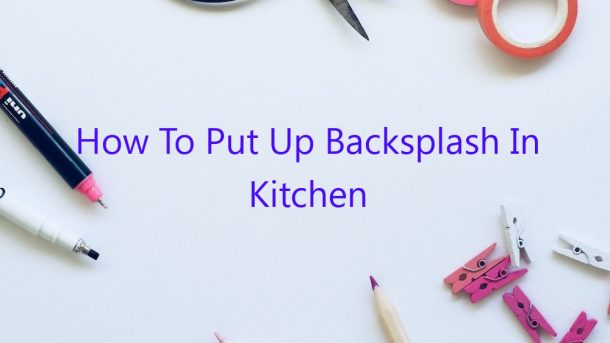Installing a kitchen backsplash is a great way to add style and protection to your kitchen walls. There are many materials and designs available, so you can create a backsplash that perfectly complements your kitchen’s décor.
To install a kitchen backsplash, you’ll need:
– Tiles or other backsplash material
– Thinset mortar
– Grout
– Tile cutter or wet saw
– Ruler or tape measure
– Level
– Pencil
– Square
– Notched trowel
– Bucket
– Sponge
– Wire brush
– Safety glasses
– Dust mask
– Gloves
1. Decide on the material and design for your kitchen backsplash.
There are many materials and designs to choose from, so take your time and decide on the perfect one for your kitchen. Tiles are a popular choice, as they come in a variety of colors, sizes, and shapes. You can also use metal, glass, or stone tiles.
2. Measure the area where you will be installing the backsplash.
Use a ruler or tape measure to measure the length and width of the area. This will help you determine how much backsplash material you will need.
3. Cut the backsplash material to size.
If you’re using tiles, use a tile cutter or wet saw to cut them to size. If you’re using a different material, cut it to the desired size.
4. Apply a layer of thinset mortar to the wall.
Use a notched trowel to apply a layer of thinset mortar to the wall. Make sure the mortar is evenly spread and the notches are deep enough to hold the tiles or other material.
5. Place the backsplash material on the mortar.
Carefully place the backsplash material on the mortar. Make sure it is evenly spaced and level. Use a square to make sure the tiles are straight.
6. Apply more mortar to the backsplash.
Use a notched trowel to apply more mortar to the backsplash. Make sure the mortar is evenly spread and the notches are deep enough to hold the tiles or other material.
7. Allow the mortar to dry.
The mortar will need to dry for 24 hours before you can grout the backsplash.
8. Grout the backsplash.
Use a grout float to spread the grout over the backsplash. Make sure the grout is evenly spread and the gaps between the tiles are filled.
9. Allow the grout to dry.
The grout will need to dry for 24 hours before you can clean it.
10. Clean the backsplash.
Use a sponge and warm water to clean the backsplash. Make sure all the grout is removed.
11. Seal the backsplash.
If desired, seal the backsplash with a sealant to protect it from water and stains.
Contents
What is the easiest way to install kitchen backsplash?
Installing a kitchen backsplash may seem daunting, but it can be a relatively easy DIY project. Here is the easiest way to install a kitchen backsplash:
1. Clean the surface of the wall behind the stove and make sure it is free of dust, dirt, and grease.
2. Measure the surface area where the backsplash will be installed and purchase the appropriate amount of backsplash tile.
3. Start by installing the tile along the top edge of the backsplash area. Use a level to make sure the tiles are straight, and use spacers to create even spacing between the tiles.
4. Work your way down the backsplash area, installing the tiles one at a time. Make sure to use a level and spacers to ensure that the tiles are straight and even.
5. Seal the grout once the tiles have been installed. Allow the grout to dry for 24 hours before using the stove.
When putting up backsplash where do you start?
When it comes to kitchen renovations, many homeowners choose to add a backsplash. This can be a great way to add some personality and style to your kitchen, and it can also be a functional addition, helping to protect your walls from spills and splatters. If you’re thinking about adding a backsplash to your kitchen, one of the first decisions you’ll need to make is where to start. Here are a few tips on how to choose the right spot for your backsplash.
One of the most important factors to consider when choosing the location for your backsplash is the type of material you plan to use. Some materials, such as ceramic tile, are very durable and can withstand a lot of wear and tear, while others, such as vinyl tile, are not as durable. If you’re using a fragile material, such as glass tile, you’ll need to be especially careful to avoid placing it in a high-traffic area.
Another thing to consider is the amount of space you have to work with. If you have a small kitchen, you’ll probably want to choose a smaller backsplash. Conversely, if you have a large kitchen, you may want to go for a bigger backsplash.
Finally, you’ll need to take into account your kitchen’s layout and design. If you have a busy kitchen with a lot of cabinets and appliances, you’ll want to choose a backsplash that doesn’t create too much of a visual distraction. On the other hand, if you have a more open kitchen with a lot of counter space, you may want to choose a bolder backsplash design.
Once you’ve considered these factors, you’ll be able to choose the right spot for your backsplash. If you’re not sure where to start, here are a few tips to help you get started.
1. Decide on a style.
Before you can choose a location for your backsplash, you’ll need to decide on a style. Are you going for a traditional look, or something more modern? Once you’ve decided on a style, you’ll be able to narrow down your options.
2. Consider your kitchen’s layout.
Take a look at your kitchen’s layout and design. If you have a lot of cabinets and appliances, you’ll need to choose a backsplash that doesn’t create too much of a visual distraction. On the other hand, if you have a more open kitchen with a lot of counter space, you may want to choose a bolder backsplash design.
3. Choose a material.
The type of material you choose will also play a role in determining the right spot for your backsplash. Some materials, such as ceramic tile, are very durable and can withstand a lot of wear and tear, while others, such as vinyl tile, are not as durable.
4. Consider your budget.
Backsplashes can be expensive, especially if you choose a high-end material like marble or granite. Keep your budget in mind when choosing a material.
Once you’ve considered these factors, you’ll be able to choose the right spot for your backsplash. If you’re not sure where to start, here are a few tips to help you get started.
1. Decide on a style.
Before you can choose a location for your backsplash, you’ll need to decide on a style. Are you going for a traditional look, or something more modern? Once you’ve decided on a style, you’ll be able to narrow down your options.
2.
How do you put in a kitchen backsplash?
Installing a kitchen backsplash is a great way to add personality and style to your kitchen. There are a variety of materials and designs to choose from, so you can find the perfect backsplash for your kitchen.
There are a few things to consider when installing a kitchen backsplash. First, you need to decide what material you want to use. There are a variety of materials to choose from, including ceramic tile, glass tile, metal tile, and stone tile.
Once you’ve decided on the material, you need to measure the space and figure out how much material you need. Be sure to leave enough space between the countertop and the top of the backsplash to avoid water damage.
Once you have the material and measurements, it’s time to start installing the backsplash. The installation process varies depending on the material you choose, but most installations involve adhesive or mortar. Follow the manufacturer’s instructions carefully to ensure a proper installation.
Once the backsplash is installed, it’s time to enjoy your new kitchen addition!
Can I install kitchen backsplash myself?
Installing a kitchen backsplash is a great way to add personality and visual interest to your kitchen. It can also be a way to protect your walls from spills and splatters. While it may seem like a daunting task, it is actually a relatively easy project that you can do yourself.
The first step is to decide what material you want to use for your backsplash. There are a variety of materials to choose from, including ceramic tiles, mosaic tiles, metal, and glass. Once you have decided on a material, you need to determine the size and shape of your backsplash.
Once you have the measurements, you can purchase the material and start installing it. Be sure to read the instructions carefully, as each material may require a different installation method.
If you are installing ceramic or mosaic tiles, you will need to apply adhesive to the wall and then place the tiles in the desired position. Be sure to leave a small space between the tiles for grout.
If you are installing metal or glass, you will need to use a metal or glass adhesive to attach the material to the wall.
Once the adhesive has dried, you can finish the installation by grouting the tiles.
It is important to allow the adhesive and grout to dry completely before using your kitchen. Depending on the type of adhesive and grout you use, this could take anywhere from 24 to 48 hours.
If you are unsure whether you can install a kitchen backsplash yourself, it is best to consult with a professional.
How do you prep a wall for backsplash?
Installing a backsplash is a great way to add some personality and protection to your kitchen walls. Before you get started, it’s important to prep the wall properly. Here’s how to do it:
1. Clean the Wall
The first step is to clean the wall. Make sure to remove all dirt, dust, and grease. This will help the backsplash adhere properly to the wall.
2. Apply a Primer
Next, apply a primer to the wall. This will help the backsplash adhere better and will also help to protect the wall from moisture.
3. Apply the Backsplash
Once the primer is dry, you can apply the backsplash. Make sure to follow the manufacturer’s instructions carefully.
4. Seal the Backsplash
Once the backsplash is in place, you’ll need to seal it. This will help to protect it from moisture and will keep it looking new for years to come.
Does backsplash go behind stove?
When it comes to kitchen design, there are a few key decisions to make: what type of countertops to install, what color to paint the walls, and whether to include a backsplash. For many homeowners, the decision of whether or not to install a backsplash is a difficult one. One of the questions that often arises is whether the backsplash should go behind the stove.
There are a few factors to consider when deciding whether to install a backsplash behind the stove. One of the most important is safety. A stove can get very hot, and if there is no backsplash, it is possible for flames or grease to splash up and cause a fire. A backsplash can help protect against this by deflecting flames and grease back down to the stovetop.
Another factor to consider is aesthetics. A backsplash can add visual interest to a kitchen and can help tie the look of the kitchen together. It can also help to protect the walls from grease and splatters.
There is no one-size-fits-all answer to the question of whether or not to install a backsplash behind the stove. It is important to consider the individual needs of each kitchen and make a decision based on those needs. In most cases, a backsplash is a good idea, but there may be some cases where it is not necessary.
Where should backsplash end cabinet or countertop?
There is no one-size-fits-all answer to the question of where a backsplash should end—it depends on the specific situation. However, there are a few factors to consider when making this decision.
One important consideration is the material of the backsplash. If it is a tile backsplash, it will likely need to extend all the way to the countertop to avoid grout lines that are noticable and unsightly. However, if the backsplash is made of a different material, such as stone or metal, it can stop short of the countertop and still look nice.
Another thing to consider is the style of the kitchen. If the cabinets and countertops are very traditional, it might look better to have a backsplash that extends to the countertop. However, if the kitchen has a more modern or contemporary style, a shorter backsplash could look better.
Ultimately, the best way to decide where a backsplash should end is to consider all of the factors involved and make a decision that will look best in the specific kitchen.




